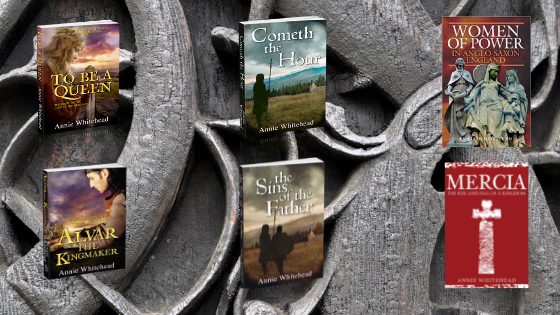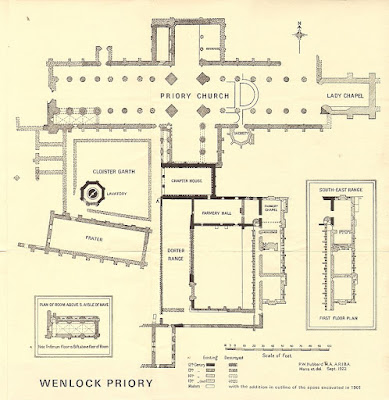My most recent novel is Book 2 of 2 in the Tales of the Iclingas series, which began with Cometh the Hour and the story of Penda, the last pagan king of Mercia and his struggles against the oppression of Mercia by Northumbria.
The Sins of the Father is the follow-up, and focuses on the next generation, in Mercia and in Northumbria, and how the children of the great warlords cope with the legacy left by their fathers. Some try to emulate their father, some try to forge a new path, and some resort to murder just to get noticed…
Penda of Mercia was seemingly unusual at this time for having married only once and, if that’s the case, then he and his only wife had a great number of children. (There are nine of them in my stories, although one is the son of Penda’s wife by a previous marriage, a boy whom Penda adopts as his own. And I made two of the girls twins, to give their poor mother a break from all those pregnancies.)
Tracking them down is not easy because very little was written about Penda himself, beyond his dealings with Northumbria, and even that was written by a Northumbrian (Bede) so is not always favourable, as you might imagine!
So in order to establish who his children were, we have to start elsewhere and join up the dots. We might not be told that they are Penda’s sons and daughters, but sometimes we do know that they were, say, the brother of one of his children, or we hear of a granddaughter of his, and her maternal aunt, and thus we know that aunt was Penda’s daughter, so we work backwards and voila!
I don’t mind wavy lines between those dots when it comes to writing fiction, but some just didn’t match at all. It’s at that point that you have to decide to leave people out of your story, no matter how intriguing they might be…
Osweard
This man was supposedly a brother of Penda’s son Ethelred (again with the backwards info!) He is mentioned in two charters of AD714 in relation to land granted to a bishop, or rather, how the bishop came by these lands. These charters are unlikely to be genuine and the only other mention of Osweard was in the account of the bishop’s life which essentially repeats the information, saying, ‘A short time later, I acquired another estate with this one from Osweard, the brother of the aforementioned king [Ethelred]’. I think it’s safe to say that the bishop, like so many before him and afterwards, was trying to make a case for land ownership which probably wasn’t as water-tight as he might have wished.
 |
| Window in St John's Church, Chester, depicting Ethelred of Mercia. Accreditation Link |
I also think nine children is more than enough, even for a saga that spans two books and three generations, so Osweard didn’t get even a walk-on part. I had some more fun with the next generation though.
Rumwold
There is a curious story concerning a supposed grandson of Penda’s, a certain Saint Rumwold. According to tradition, he was a baby who died at just three days old. The Vita Sancti Rumwoldi, the eleventh-century account of his life, says that he was able to speak at birth, preached on wisdom and the Trinity, and predicted his own death, giving precise instructions regarding where his body was to be laid to rest.
.jpg) |
| St Rumwold's Well, Buckinghamshire Accreditation Link |
It is said that he was the grandson of Penda and the son of an unnamed king of Northumbria. In which case, he can only have been the son of one of Penda’s daughters married to the Northumbrian line. Except that only one of Penda’s daughters married a Northumbrian, and he was never king of the whole of Northumbria, though he was, briefly, a sub-king of its southern portion. There doesn’t seem to be any corroboration for this tale, so I left the precocious Rumwold out of the story.
Ruffin and Wulflad
There is no doubt that Wulfhere (known in my story as Wulf to his family) was a son of Penda’s. But there’s a curious seventeenth-century anecdote which tells that, along with his children Werburgh (Werbyra in my novel) and Cenred, he had two sons called Wulfad and Ruffin. These two boys were, according to the story, baptised by St Cedd which so offended their father that he ‘killed them both with his own hands.’ Wulfhere was horribly tormented by what he had done, and ‘could find no ease’ until he went to St Cedd, who absolved him if he would suppress idolatry and establish Christianity throughout Mercia. It also says that the king built many churches and monasteries, among them Peterborough, although it is likely that the monastery there (Medeshamstede) was founded earlier, and by Wulfhere’s elder brother.
 |
| Detail of a 14th-Century Charter transcription of an Anglo-Saxon Charter which purports to show Wulfhere's founding of Medeshamstede Public Domain Image |
That’s not the only problem I have with this story though. Little Werbyra became an abbess and saint, Wulfhere himself was a Christian, and it seems highly unlikely that he would have killed two of his sons because they’d been baptised. Since this was a period when couples could separate to take up the religious life, you’d think his wife would have left him if he'd murdered two of her children, or even step-children, yet she didn’t. When Wulfhere discovered that another king had apostatized and gone back to his heathen ways, Bede tells us that Wulfhere sent a bishop to ‘correct their error.’ Improbable then, that he would kill any Christian children of his own. It could, of course, have happened before his own conversion to Christianity, but it all seems very unlikely to me. I left them out of the book because the murder of two children by their father the king would have taken my story in an entirely different direction…
 |
| St Werburgh's Pilgimage Badge Public Domain Image |
Sometimes, when doing historical detective work, it’s best to leave the bodies right where you find them, and walk away!
About The Sins of the Father
A father’s legacy can be a blessing or a curse…
AD658: The sons of Penda of Mercia have come of age. Ethelred, the youngest, recalls little of past wars while Wulf is determined to emulate their father, whose quest to avenge his betrayed kinswomen drew him to battle three successive Northumbrian kings.
Ecgfrith of Northumbria is more hostile towards the Mercians than his father was. His sister Ositha, thwarted in her marriage plans, seeks to make her mark in other ways, but can she, when called upon, do her brother’s murderous bidding?
Ethelred finds love with a woman who is not involved in the feud, but fate intervenes. Wulf’s actions against Northumbria mean Ethelred must choose duty over love, until he, like his father before him, has cause to avenge the women closest to him. Battle must once more be joined, but the price of victory will be high.
Can Ethelred stay true to his father’s values, end the feud, keep Mercia free, and find the path back to love?
[A version of this article first appeared on author Charlene Newcomb's blog in 2021]






























